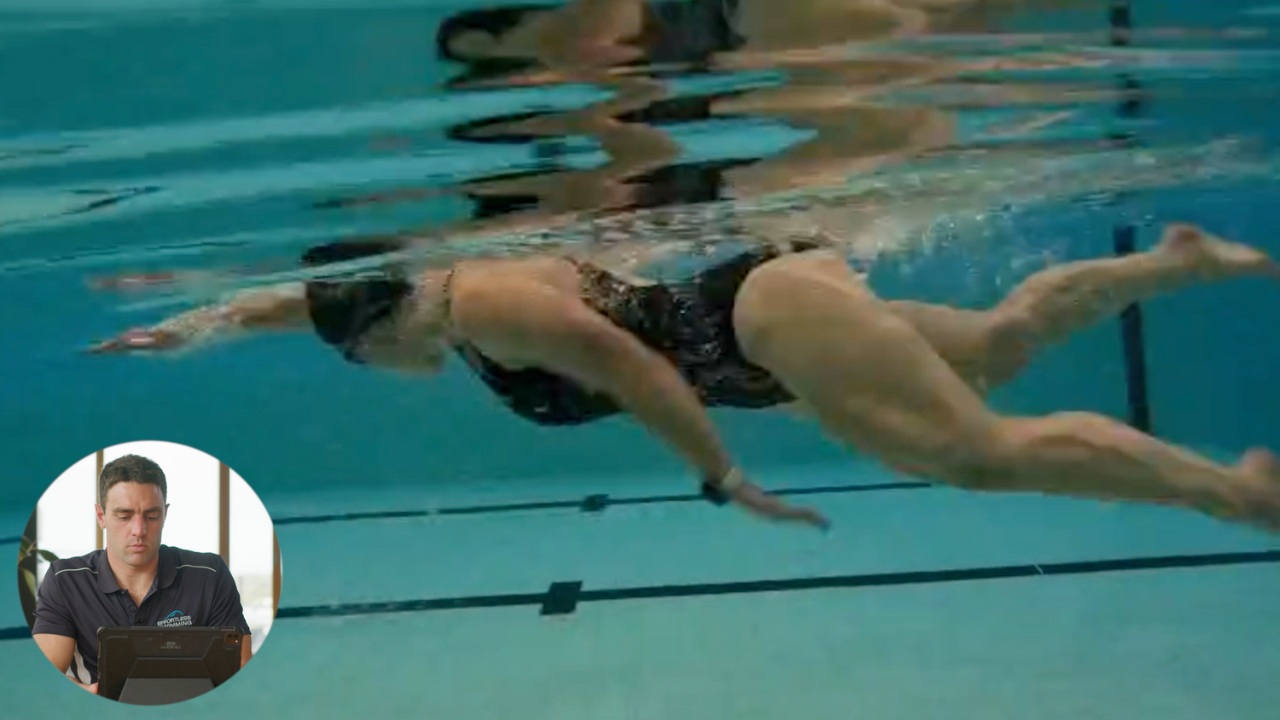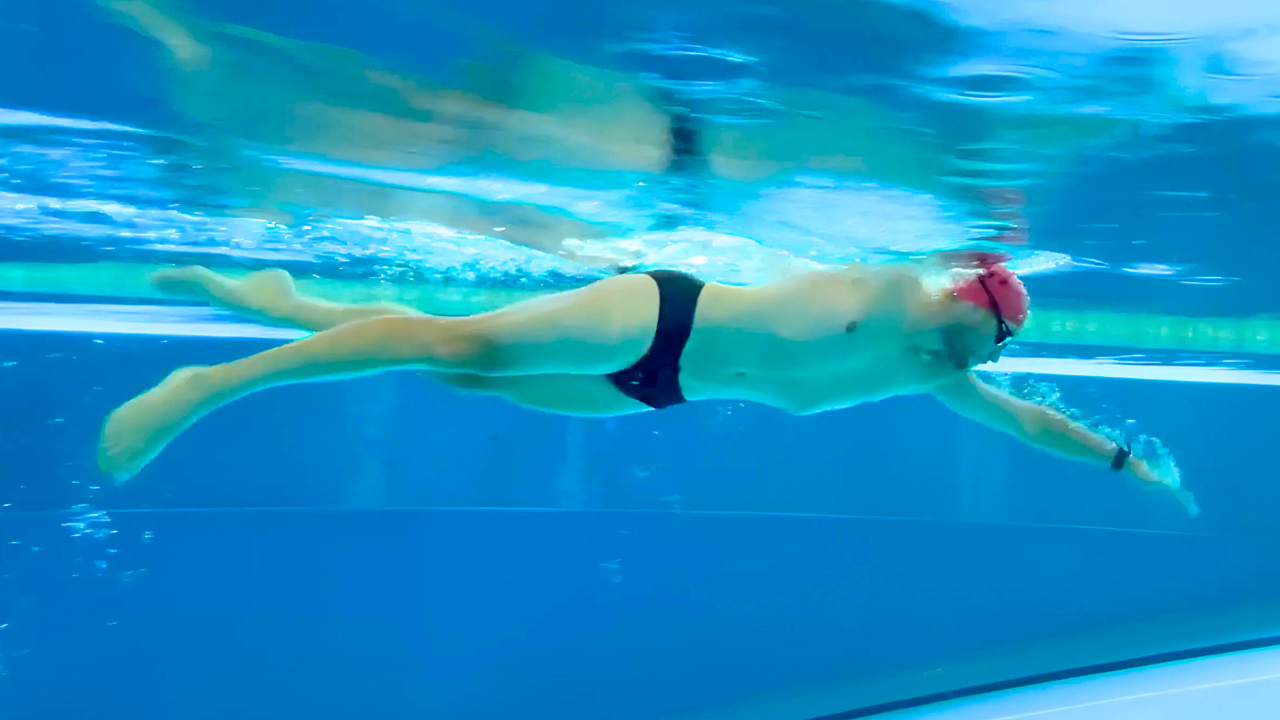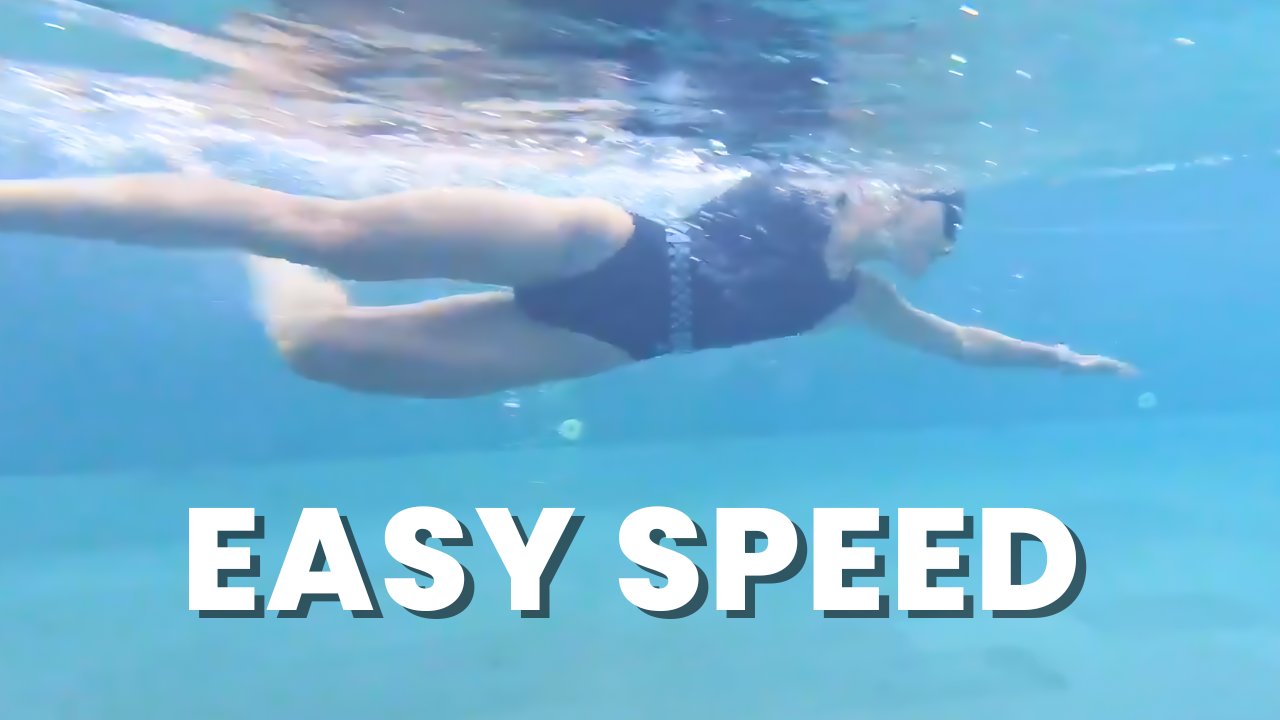In this Feedback Friday episode we look at a triathlete stuck at the 2:30/100m pace. We’ll look into how he can improve his body position and catch to radically improve his swimming.
Transcription:
From there to there, that’s the catch. What we want to have is the hand and forearm moving downwards, so moving down in this sort of direction, getting the fingers to point down without the upper arm moving back too much.
Welcome to Feedback Friday where we analyze someone’s stroke, and we look at what they can do to swim faster. In this episode, we have a triathlete who’s around the 2:30 mark per a hundred in his races, so we’re going to look at what he can do to bring that down. Often when someone is around that, that sort of mark, body position is a big one and an effective catch is often one of the key things that we look at as well. In terms of getting faster, we like to look at the breathing and the breathing here. It looks like that exhalation is coming from the nose. Most of it is coming in while he’s turning his head, which is good. He may not need to change the way he’s breathing and in general, he’s looking mostly to the side there. He’s not lifting his head up too high, which is good.
If we look at his head position here, we’ll see that, okay, he’s looking about 20, 30 degrees in front, which is fine, and the neck has been kept long. That head position, for now, it looks like it’s about right. When you look at body position, what we ideally want to have is that horizontal body position because if anything’s coming down below that line, the amount of drag that creates makes it feel very hard to hold any sort of speed for any sort of time. It can really just feel like that’s the thing that is holding you back, and it is. The most important thing is to minimize drag, so that’s what we look to start with.
If we look at this and someone’s hips and their legs are dropping down that much, there’s a couple of things that can cause it. It can really come down to what the arms are doing through the catch and the pull, the timing of the stroke, the breathing and the rotation and sometimes, is the kick being effective or not. What I would probably look to do if I was this swimmer is I’d get a snorkel, get a front snorkel, and I would just practice kicking face down in the water with both hands out in front. That way you don’t need to worry about lifting your head to breathe. I’d work on having a smaller, narrow kick looking to get the head, the hips, and the heels at the surface. When you do that you get to really experiment and discover, where’s my point of balance? How much pressure do I need to put through the chest? How much lift do I need to have through my hips and with my legs in order to get up much more horizontal in the water?
It can take quite a while to find that point of balance, and it can certainly take a bit of practice to be able to get that into the stroke and to be able to continue that when you do introduce the breathing. I would be practicing that because if we look at the body position, you’ll see that we’ve got kind of the head here, good. The neck is long, a bit too much of an arch through the spine, and then the legs come down below that. What we would want to aim to have is to be quite a bit straighter than that. Yeah, we’ll have a bit of a curve through the back, but somewhere a bit more in that position. That means he’s probably going to have to lift his legs up a bit more using his hips.
He’s probably going to have to engage the core a little bit more to keep this a bit straighter. That will come with time and practice, but it can be good to just keep it really simple, to begin with. Just some basic kicking drills with a snorkel on to get the feel for it. After that, he’ll probably have a pretty good sense of what it feels like in order to keep his body up that little bit higher. That’s where I’d start. That could even take three, four or five weeks in order to really get a sense of it, but it doesn’t mean he’s not swimming for that three to five weeks. He might just do a couple of 50s where he’s doing 25 front kick drill, 25 swim. Then he might be doing the arms by side kick rotation drill, 25 swims. You still want to be swimming as you’re doing that, but you also want to have that focus on body position, so that would be the first thing, body position, and posture really.
Then the other thing that would be worth starting to work on pretty soon after that is the catch in the pool because at the moment, particularly with the left arm, there’s not a lot that he’s getting out of that arm. The entry looks quite good. The hand is entering there a bit close to the head. I’d enter a little bit further out just to reduce some of that drag, but out in front here. That position is pretty close to where you want to be. Then as he starts to pull back from there to there, that’s the catch. What we want to have is the hand and forearm moving downwards, so moving down in this sort of direction, getting the fingers to point down without the upper arm moving back too much. That’s what will get him into a high elbow catch position.
You can see as he goes through there, the fingers continue to mostly point forwards and the upper arm and the elbow start to pull back straight away. When he finishes the catch, which is there, if we draw a line from the shoulder to the fingertips, that elbow is well below that line and that’s what we call a dropped elbow position. A high elbow catch would look a little bit like this, what I’m going to draw in yellow, somewhere in that sort of position. Now it doesn’t need to be extreme with that high elbow catch, but any improvement in getting the hand and forearm angled back a little bit more, a little bit more vertical, that is going to make a huge difference in propulsion, a big, big difference. We’d want to work on that left arm catch and then even here as you’re passing under the shoulder, what you’ll see with most top swimmers, shoulder, elbow, hand is all aligned underneath there.
One, two, three, all of that is lining up because if we’ve got the upper arm there and the hand out in front, that’s much less surface area than if we’ve got shoulder elbow hand-aligned. We’d want to work on getting that in place. We call that the power diamond position because if we look from the front, what we would want to see here is with the left arm, we’d want to have the elbow out to the side, hand, and forearm in that sort of position, but at the moment it’s just quite dropped. I’ll talk about how he could approach it in a moment, but we’ll just have a look at the right arm catch. That’s the left one that’s dropping quite a bit and that can actually contribute to the drop in the lower half.
With the hand and forearm pressing downwards from there to there pressing down in that direction, that’s really why you see the chest up so high, but the legs down. If you’re pushing down here, obviously, it’s going to push up there, but it’s going to have the other effect of dropping down the back half and then this right hand side. The entry is nice, entering there, reaching forwards. That’s quite a good position to be in. Great position to start the catch. He then just goes down a bit too early and a bit too deep with that arm, so it’s going down quite deep and straight. I would aim to be more patient with the catch as in when he enters, spend a bit longer, reaching forwards and then pull through as opposed to coming in and just going straight down into the catch because it’s very hard to get a comfortable breath when your arm is down there. It’s very hard to keep the head out of the water.
We need that arm out in front just a little bit more to provide that stability and balance there. If you see it from the front, so he comes in. It’s in line with the shoulder, that’s good. It just drops down a bit too early. If we look at where the arm is, it’s probably into the center a bit too much. Where we’d want to get to in that position is out quite a bit wider with a bit more bend in the elbow. When we look at the angle there we like to see 100 to 120 as you’re about to pass under the shoulder, kind of when you finish the catch there. That’s when you can typically use the lats in the best possible way as he’s pressing back. Yeah, because he’s so deep that hand is then just sort of coming up past the hip.
What it will feel like for him is look, he’s probably going to feel like he’s gliding on that right arm a little bit and like he’s reaching for the wall in front of him for a little bit longer before he starts to pull through. Then as he moves through the catch, it’ll probably feel like he’s going quite shallow and maybe quite wide with the elbow and the upper arm there. Now that can be a really challenging thing to change just by swimming more and thinking about that change because it’s difficult to learn that the motor patterns that are required there to be able to improve that just by swimming and just by trying to think about it.
What we like to do and the reason that we spend quite a bit of time on drills, and we recommend most people do a couple of drills in their warmup every time that they swim. The reason we do that is that if you want to change that muscle memory, and you want to learn new motor patterns, then it can be helpful to break down the things that you’re trying to learn into more simple steps. The simplest way that we know how to improve the catch for most adult triathletes and swimmers is the YMCA drill progression. The first drill is the YMCA drill, and we put up a video on this on Tuesday. If you have a look back, we explain the YMCA drill in detail and you can see it here. That’s the first drill of the sequence. There’s two more.
To me, we made up these drills because we found that it’s quite hard for most people who don’t have a swimming background or who didn’t learn to swim as a youngster. It’s quite difficult for them to be able to learn these motor patterns. What the YMCA drill does is it breaks it down into the four most important parts of the stroke and then it helps you perfect those. Then that’s going to help change your stroke. I would recommend the YMCA drill progression, which you can find in the video membership. It’s currently under the core principle number four, which is developing an effective catch and pull if you look at those five core principles that we teach to help swimmers and triathletes improve their stroke.
That’s what I’d be aiming for. Get that body position right and, and then look at improving the catch and the pull. That’ll do a pretty good job of improving the body position and also increasing the propulsion. With those two things, that could and probably will get him pretty close to that two minute mark. Then we’d probably just want to reassess, okay, where’s the stroke at? What do we need to work on then? He can expect it to feel very different. It might feel better straight away, but more times than not, it just feels different, a little bit awkward and uncomfortable. You can sometimes feel like a deer on ice when you’re making these changes to the stroke.
If you can put up with those uncomfortable feelings for a number of weeks you will get better and you will get faster. Yeah, as you can see as we go through this a bit more, if you’re swimming with the pool boy and your hips and your legs aren’t quite at the surface there, then it probably just means yeah, you need to work on that posture and body position, looking for that, finding that that point of balance and probably just work on the catch and the pull, getting into that high elbow catch a little bit more effectively.
That’s the end of this episode of Feedback Friday. If you are in Australia, we run clinics around the country. We also do camps in Thailand, Hawaii and also in Queensland here in Australia. If you are based overseas or even in Australia and you want to work with us, then check out our effortless swimming membership. That’s where we have people everyday sending us videos. We do an analysis. We look at what drills they should do. We give them a small drill set to do as part of their warm-up every single session. Then in two or three weeks’ time, they send another video to check up where they’re at.
Then we just continue to refine their stroke over the course of a couple of months and a couple of years. The results that you can get through that can far exceed the benefit you get from maybe adding another two sessions in or maybe buying a new wetsuit. Swimming is primarily about technique and that’s what we’re here to help you with. You’ll find links in the description below for all of that. Thanks very much for watching. I’ll see you next week.









